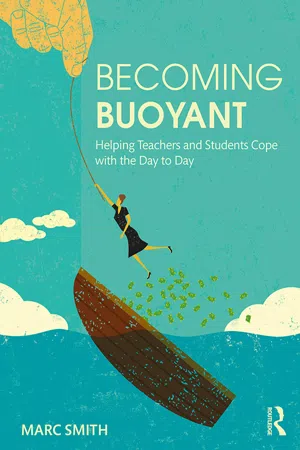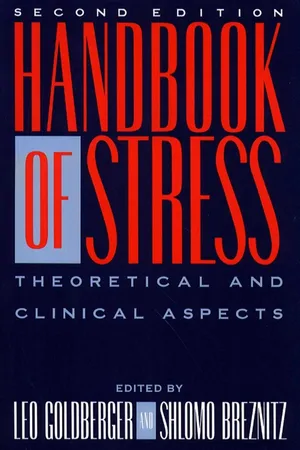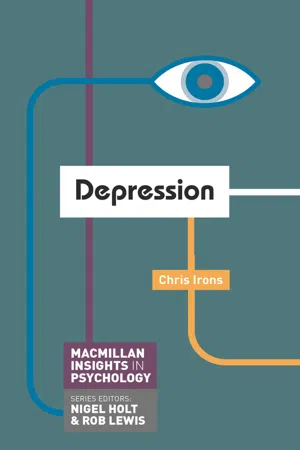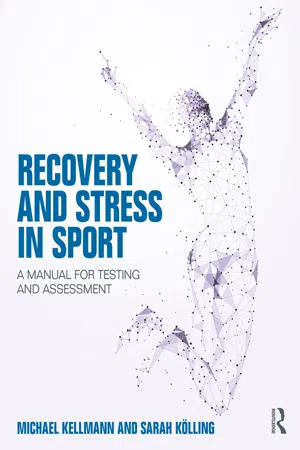Psychology
The Social Readjustment Rating Scale
The Social Readjustment Rating Scale, developed by Thomas Holmes and Richard Rahe, is a tool used to measure the impact of various life events on stress levels. It assigns numerical values to different life events, such as marriage, divorce, and job changes, based on the perceived stress they cause. The total score can indicate an individual's susceptibility to stress-related health issues.
Written by Perlego with AI-assistance
Related key terms
Related key terms
1 of 4
Related key terms
1 of 3
4 Key excerpts on "The Social Readjustment Rating Scale"
- Marc Smith(Author)
- 2020(Publication Date)
- Routledge(Publisher)
In a similar way, stress research has traditionally investigated dramatic life events and severely taxing situations. Early research highlighted the role of major life events, with Thomas Holmes and Richard Rahe of the University of Washington School of Medicine introducing their Social Readjustment Rating Scale back in the 1960s (Holmes & Rahe, 1967). Life events are anything that require us to adjust to change, mainly negative events like the loss of loved one, losing our job or getting divorced, but positive events such as going on holiday or Christmas can also ramp up the stress levels and can result in both physical and psychological illness. An example of the scale can be seen in Box 3.1. Box 3.1 The Social Readjustment Rating Scale (SRRS) The SRRS is an inventory of common stressors. These stressors can be both positive and negative but all represent a change that requires the individual to adapt to environmental changes. Each life event is assigned a value, or ‘life changing unit’ that reflects the relative amount of stress the event causes. Stress is seen as cumulative, so the scale requires the individual to identify all relevant events that have taken place in the past year to estimate the total stress units. Note: Only a selection of life events are included in the table below. Life event Value Death of a spouse 100 Divorce 73 Death of a close family member 63 Marriage 50 Retirement 45 Change in financial state 38 Son or daughter leaving home 29 Begin or end school 26 Change in schools 20 Change in sleeping habits 15 (Holmes & Rahe, 1967) █ From life experiences to daily hassles All life stresses are both actual real events and subjective interpretations. Your world could be falling apart at the seams and you might display little outward signs of stress, yet on another occasion you might lose sleep because you can’t decide on new wallpaper for the living room- eBook - ePub
- Leo Goldberger, Shlomo Breznitz, Leo Goldberger, Shlomo Breznitz(Authors)
- 2010(Publication Date)
- Free Press(Publisher)
In 1964, Holmes and Rahe (1967) devised the Social Readjustment Rating Questionnaire (SRRQ) to obtain numerical estimates of the average degree of life change and read-justment that subjects assign to changes in their lives. The life changes studied involved modifications of sleeping, eating, social, recreational, personal, and interpersonal habits that required or indicated varying degrees of adjustment. Holmes and Rahe subsequently revised the original scale to become The Social Readjustment Rating Scale (SRRS), which assigned magnitudes to each of 42 life change items according to the amount, severity, and duration of adjustment each requires. The scaling instrument was found concordant among various segments of the U.S. population and between American citizens and people of other cultures.Holmes and Rahe then devised the Schedule of Recent Experience (SRE), a self-administered paper-and-pencil survey that listed life changes by year of occurrence. The current version of the SRE, the recent life changes questionnaire (RLCQ), retains the essence of the 42 original life change questions of the SRE, but the wording of questions has been altered for clarity and to allow for clarity and to allow for specific options of response. Instructions were placed at the end of the RLCQ so that subjects could self-scale their own subjective life change scores for each change they had recently experienced. Patients obtained at least three different life change scores for analyses with various illness criteria. First, subjects obtained a 6-month life change unit (LCU) score for the 42 SRE items. Second, they scored a sum of all recent life changes indicated in a 6-month time period. This method was called unit scaling and proved to be particularly useful with subjects between 18 and 25 years of age, a group that usually experiences few high LCU life changes. (The investigator is recommended to use the LCU scoring system when dealing with samples of older subjects who may have experienced more life changes such as marriage, childbirth, divorce, business readjustment, illnesses of family members, death in the family, and so on). Finally, a subjective life change unit (SLCU) score was obtained that yielded a 6-month SLCU total for the original 42 SRE life change questions; SLCU scores were then subtracted from the standard LCU scores for those 42 questions. - eBook - ePub
- Chris Irons(Author)
- 2014(Publication Date)
- Bloomsbury Academic(Publisher)
They developed a 43-item scale (The Social Readjustment Rating Scale – SRRS; Homes and Rahe, 1967), in which 43 different stressful situations (e.g. death of a spouse, losing your job, moving house) are ranked and given a score out of 100 (death of a spouse rated as the highest stressful life event at 100). Participants make a note of how many of the 43 stressful life events have occurred to them over the past year, and the scores given to each item are added together. The idea here is that higher total scores are associated with greater risk of physical illness. If you are interested in looking at this scale, a version can be found at: http://www.mindtools.com/pages/article/newTCS_82.htm. Holmes and Rahe (1967) found that higher scores on the SRRS were related to higher levels of illness (although this was quite a small statistical relationship), and subsequently, to depression (Costantini et al., 1973; Rahe, 1979). From Holmes and Rahe’s (1967) work, it was clear that whilst overall stress was important, certain types of stress were seen to be more significant or ‘stressful’. Holmes and Rahe rated the top three most stressful events as: (i) death of a spouse, (ii) divorce and (iii) marital separation. Whilst there may be a number of elements common to these events, one issue in particular seems to be important: loss. In fact, the research literature over the past three decades has supported this finding, and has highlighted that interpersonal loss – be it through death, the ending of a relationship or the perception that a relationship might be permanently ending – appears to be a powerful source of stress and closely associated with depression. As a concept, loss featured as a central part of psychodynamic theories, and to a lesser extent, cognitive theories of depression explored in the previous chapter - eBook - ePub
Recovery and Stress in Sport
A Manual for Testing and Assessment
- Michael Kellmann, Sarah Kölling(Authors)
- 2019(Publication Date)
- Routledge(Publisher)
Short Recovery and Stress ScaleScope and application
The Short Recovery and Stress Scale (SRSS) measures the current recovery-stress state of an athlete multidimensionally with eight items on emotional, mental, physical, and overall levels. It was designed to adequately present acute recovery-stress states of an athlete in a valid, sport-specific and economical way. Coaches whose athletes complete the SRSS (in the morning after a supposed recovering night’s sleep) will get information that is valuable for the daily training schedule and, if necessary, for adaptation of training. By regularly measuring the athlete’s individual psychophysical stress state, overload symptoms can be identified at an early stage and in consequence, the performance control and training prescription can be optimized.The SRSS was derived from the eight scales of the ARSS which were then grouped into the Short Recovery Scale and the Short Stress Scale and consist of four items each. The SRSS is an abridged version of the ARSS, which implies that the same changes during the development process that were made to the English ARSS were also applied to the English SRSS. No changes occurred in the actual items of the SRSS. However, the descriptive examples listed under each item were modified in the translation and data collection processes to match the structure of the ARSS. The scale labels of the ARSS are referred to as items of the SRSS. Each item of the SRSS lists the four ARSS adjectives as descriptors (see Figure 5.1 ).Figure 5.1 Sample item of the Short Recovery ScaleThe SRSS can be used in sport-scientific practice as well as in scientific research. Previous studies in Germany did not show any difference in perception and response bias for adults (Kellmann et al., 2016). With regard to the emotional items only, restrictions can be anticipated with adolescents (between 16 and 18 years).1
Index pages curate the most relevant extracts from our library of academic textbooks. They’ve been created using an in-house natural language model (NLM), each adding context and meaning to key research topics.
Explore more topic indexes
Explore more topic indexes
1 of 6
Explore more topic indexes
1 of 4



